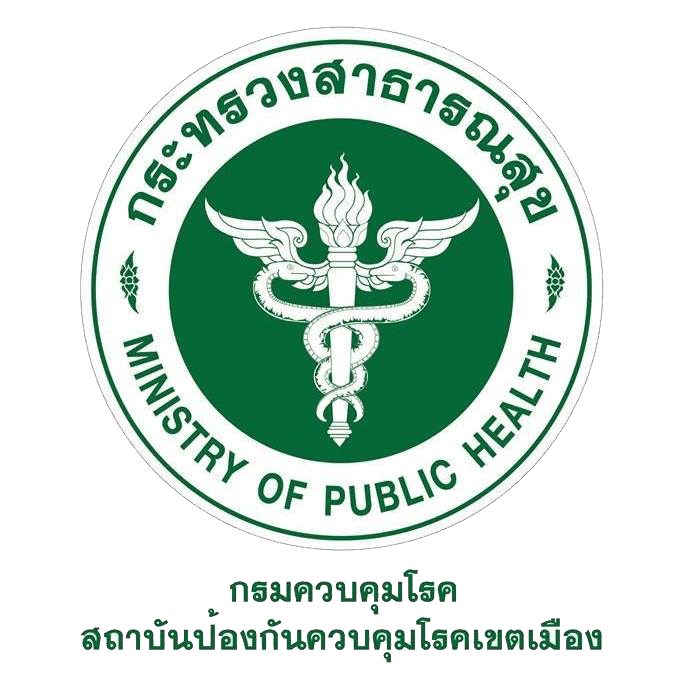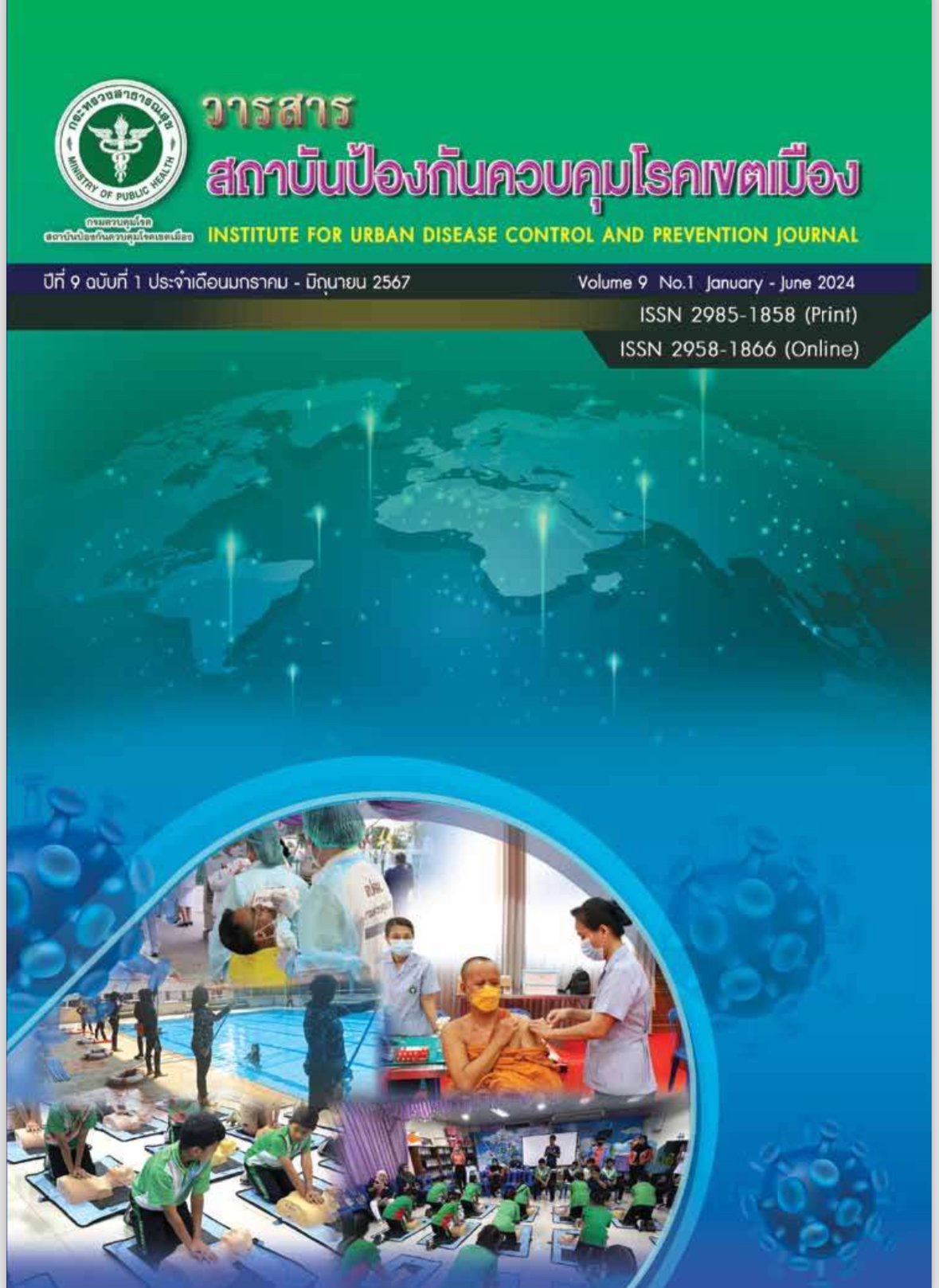พฤติกรรมการปฏิบัติตัวในการป้องกันการติดเชื้อไวรัสโคโรนา 2019 ของผู้พักอาศัยในชุมชนแออัด พื้นที่กรุงเทพมหานคร
Main Article Content
บทคัดย่อ
การศึกษาแบบภาคตัดขวางเชิงวิเคราะห์นี้มีวัตถุประสงค์เพื่อศึกษาพฤติกรรมการปฏิบัติตัวในการป้องกันการติดเชื้อไวรัสโคโรนา 2019 และปัจจัยที่มีความสัมพันธ์ต่อพฤติกรรมการปฏิบัติตัวในการป้องกันการติดเชื้อไวรัสโคโรนา 2019 ของผู้พักอาศัยในชุมชนแออัด พื้นที่กรุงเทพมหานคร โดยเก็บข้อมูลจากชุมชนแออัดจำนวน 12 ชุมชนในช่วงเดือนมกราคม – มิถุนายน 2565 จำนวนผู้ตอบแบบสอบถามทั้งสิ้น 1,820 คน เครื่องมือที่ใช้ในการศึกษาครั้งนี้คือแบบสอบถามซึ่งประกอบด้วย 3 ส่วน : ส่วนที่ 1 ข้อมูลทั่วไป ส่วนที่ 2 ข้อมูลสุขภาพ และส่วนที่ 3 พฤติกรรมในการป้องกันการติดเชื้อไวรัสโคโรนา 2019 วิเคราะห์ข้อมูลโดยใช้สถิติเชิงพรรณนา และสถิติการวิเคราะห์ถดถอยโลจิสติกเชิงพหุคูณ ผลการศึกษาพบว่าผู้ตอบแบบสอบถามมีพฤติกรรมการป้องกันการติดเชื้อไวรัสโคโรนา 2019 อยู่ในระดับพอใช้ ร้อยละ 82.54 และอยู่ในระดับดีร้อยละ 17.46 ปัจจัยที่มีความสัมพันธ์กับพฤติกรรมการป้องกันการติดเชื้อไวรัสโคโรนา 2019 ได้แก่ การมีโรคประจำตัว และประวัติการติดเชื้อไวรัสโคโรนา 2019 สาเหตุที่พฤติกรรมการป้องกันโรคโควิด 19 อยู่ในระดับพอใช้ อาจเนื่องมาจากข้อจำกัดทางกายภาพของชุมชนทำให้การปฏิบัติตามมาตรการเป็นไปได้ยาก เช่น การเว้นระยะห่างในชุมชนที่มีพื้นที่ในการอยู่อาศัยอย่างจำกัด การล้างมือในที่ซึ่งระบบสาธารณูปโภคไม่ดีเท่าที่ควร สามารถนำมาเป็นข้อเสนอแนะในการออกแบบมาตรการหรือตัวเลือกที่เหมาะสมกับชุมชนแออัดต่อไป
Article Details

อนุญาตภายใต้เงื่อนไข Creative Commons Attribution-NonCommercial-NoDerivatives 4.0 International License.
บทความที่พิมพ์ในวารสารสถาบันป้องกันควบคุมโรคเขตเมือง ถือว่าเป็นผลงานวิชาการ งานวิจัยและวิเคราะห์ ตลอดจนเป็นความเห็นส่วนตัวของผู้เขียนเอง ไม่ใช่ความเห็นของสถาบันป้องกันควบคุมโรคเขตเมือง หรือคณะบรรณาธิการแต่ประการใด ผู้เขียนจำต้องรับผิดชอบต่อบทความของตน
เอกสารอ้างอิง
World Health Organization [Internet]. Geneva: WHO; c2022. Coronavirus disease (COVID-19); 2022 [cite 2022 Aug 18]; [about 1 screen]. Available from: https://www.who.int/health-topics/coronavirus#tab=tab_1
WHO. Global Situation of Coronavirus (COVID-19). Geneva: WHO; 2022.
กระทรวงสาธารณสุข [อินเทอร์เน็ต]. นนทบุรี: กรมควบคุมโรค; c2022. สถานการณ์การระบาดของโรคโควิด19 ของประเทศไทย; 2565 [เข้าถึงเมื่อ 18 สิงหาคม 2565]; [ประมาณ 1 น.]. เข้าถึงได้จาก: https://ddc.moph.go.th/covid19-dashboard/
กรมควบคุมโรค, สำนักสื่อสารความเสี่ยงและพฤติกรรมสุขภาพ [อินเทอร์เน็ต]. นนทบุรี: สำนักสื่อสารความเสี่ยงและพฤติกรรมสุขภาพ; c2021. กรมควบคุมโรค ขอความร่วมมือประชาชนเคร่งครัดมาตรการ D-M-H-T-T-A อย่างต่อเนื่อง เพื่อป้องกันโรคโควิด 19; 2564 กรมควบคุมโรค; 2564 [เข้าถึงเมื่อ 1 พฤษภาคม 2564]; [ประมาณ 1 น.].เข้าถึงได้จาก: https://ddc.moph.go.th/brc/news.php?news=18373&deptcode=brc)
WHO [Internet].Geneva: WHO; c2023. Advice for the public: Coronavirus disease (COVID-19); 2023 [cited 2023 March 18]; [about 1 screen]. Available from: https://www.who.int/emergencies/diseases/novel-coronavirus-2019/advice-for-public
สำนักการวางผังและพัฒนาเมือง กรุงเทพมหานคร, กองนโยบายและแผนงาน. สถิติข้อมูลชุมชนในเขตกรุงเทพมหานคร พ.ศ.2561. กรุงเทพฯ: สํานักการวางผังและพัฒนาเมือง กรุงเทพมหานคร; 2561.
BBC News ไทย [อินเทอรืเน็ต]. กรุงเทพฯ: บีบีซี; c2021.โควิด-19: เหตุใดต้องจับตา "คลัสเตอร์คลองเตย" และชุมชนแออัดในกรุงเทพ หลังยอดติดเชื้อยังพุ่ง-ยอดตายทำสถิติรายวันสูงสุด; 2564 [เข้าถึงเมื่อ 1 พฤษภาคม 2564]; [ประมาณ 1 น.]. เข้าถึงได้จาก: https://www.bbc.com/thai/thailand-56968103
ธานี ชัยวัฒน์, นิชาภัทร ไม้งาม, ณัฎฐ์ศุภณ ดำชื่น, จารุวัฒน์ เอมซ์บุตร, ปกรณ์สิทธิ ฐานา, ชนลักษณ์ ชัยศรีลักษณ์. เศรษฐศาสตร์พฤติกรรมว่าด้วยเส้นทางชีวิตและกิจกรรมร่วมของครัวเรือนไทยภายใต้สถานการณ์ COVID-19. กรุงเทพฯ:สถาบันวิจัยระบบสาธารณสุข; 2563.
ดวงกมล ชาติประเสริฐ, เสริมศิริ นิลดำ. ลักษณะประชากร การรับรู้ความเสี่ยง และโครงสร้างทางปัญญาที่ส่งผลต่อพฤติกรรมสุขภาพในการป้องกันตนเองจากโรคประจำถิ่นโควิด-19. วารสารนิเทศศาสตร์. 2565;40(2):53-70.
Dejsuwannachai R. Knowledge, Attitude and Preventive Behavior toward COVID-19 among grade 10-12 students in Bangkok. Institute for Urban Disease Control and Prevention journal. 2022;6(2):1-15.
Islam S, Emran GI, Rahman E, Banik R, Sikder T, Smith L, et al. Knowledge, attitudes and practices associated with the COVID-19 among slum dwellers resided in Dhaka City: a Bangladeshi interview-based survey. J Public Health (Oxf). 2021 Apr 12;43(1):13-25.
ภัทรานิษฐ์ เหมาะทอง, วนิดา ทองโคตร, สุพรรณี อึ้งปัญสัตวงศ์. การกำหนดขนาดตัวอย่างโดยใช้สูตร Yamane. ขอนแก่น; มหาวิทยาลัยขอนแก่น: 2560.
Tampe T. Potential impacts of COVID-19 in urban slums: addressing challenges to protect the world’s most vulnerable. Cities & Health. 2021;5(sup1):S76-S9.
ปิยะนันท์ เรือนคำ, สุคนธา คงศีล, สุขุม เจียมตน, ยุวนุช สัตยสมบูรณ์, เพ็ญพักตร์ อุทิศ. ปัจจัยที่มีความสัมพันธ์กับพฤติกรรมการป้องกันโรคติดเชื้อไวรัสโคโรนา 2019 ของประชากรผู้ใหญ่:กรณีศึกษาเขตจอมทอง กรุงเทพมหานคร.วารสารวิชาการสาธารณสุข. 2565;31(Supplement 2):s247-s259.
ณฐนันทน์ ภูศรีเทศ, สรัญยา ลิ้มสายพรหม. ปัจจัยที่มีอิทธิพลต่อพฤติกรรมนิวนอร์มัลในสถานการณ์โควิด-19 ของคนวัยทำงาน ในอำเภอเมือง จังหวัดนครสวรรค์. วารสารวิชาการแพทย์และสาธารณสุข เขตสุขภาพที่ 3. 2565;19(3):285-300.
ศิริประภาพร บุญคง, ศิริวดี วดีศิริศักดิ์, พูนศักดิ์ ศิริโสม, ณิฏะญาร์ บรรเทา, ปรมาภรณ์ แสงภารา, วริดา พลาศรี. การศึกษาพฤติกรรมการป้องกันและการเฝ้าระวังโรคติดเชื้อไวรัสโคโรนา (Covid-19) ในการแพร่ระบาดระลอกใหม่ ของประชาชนในจังหวัดมหาสารคาม. วารสารวิชาการ สำนักงานป้องกันควบคุมโรคที่ 8 จังหวัดอุดรธานี. 2566;2(1):31-46.


